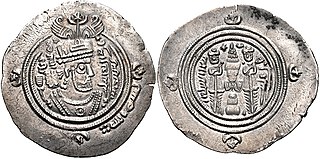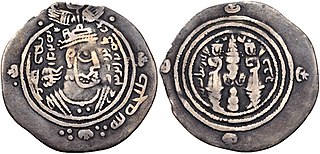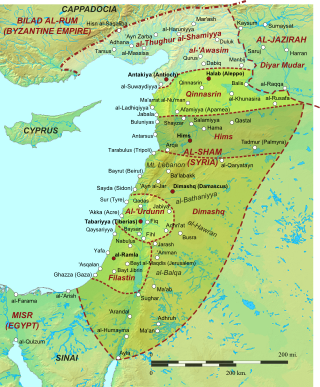
The Umayyad Caliphate or Umayyad Empire was the second caliphate established after the death of the Islamic prophet Muhammad and was ruled by the Umayyad dynasty. Uthman ibn Affan, the third of the Rashidun caliphs, was also a member of the clan. The family established dynastic, hereditary rule with Mu'awiya I, the long-time governor of Greater Syria, who became caliph after the end of the First Fitna in 661. After Mu'awiya's death in 680, conflicts over the succession resulted in the Second Fitna, and power eventually fell to Marwan I, from another branch of the clan. Syria remained the Umayyads' main power base thereafter, with Damascus as their capital.

Mu'awiya I was the founder and first caliph of the Umayyad Caliphate, ruling from 661 until his death. He became caliph less than thirty years after the death of the Islamic prophet Muhammad and immediately after the four Rashidun ('rightly-guided') caliphs. Unlike his predecessors, who had been close, early companions of Muhammad, Mu'awiya was a relatively late follower of Muhammad.

Yazid ibn Mu'awiya ibn Abi Sufyan, commonly known as Yazid I, was the second caliph of the Umayyad Caliphate, ruling from April 680 until his death in November 683. His appointment by his father Mu'awiya I was the first hereditary succession to the caliphate in Islamic history. His caliphate was marked by the death of Muhammad's grandson Husayn ibn Ali and the start of the crisis known as the Second Fitna.

Marwan ibn al-Hakam ibn Abi al-As ibn Umayya, commonly known as Marwan I, was the fourth Umayyad caliph, ruling for less than a year in 684–685. He founded the Marwanid ruling house of the Umayyad dynasty, which replaced the Sufyanid house after its collapse in the Second Fitna and remained in power until 750.

Sulayman ibn Abd al-Malik ibn Marwan was the seventh Umayyad caliph, ruling from 715 until his death. He was the son of Caliph Abd al-Malik ibn Marwan (r. 685–705) and Wallada bint al-Abbas. He began his career as governor of Palestine, while his father Abd al-Malik and brother al-Walid I reigned as caliphs. There, the theologian Raja ibn Haywa al-Kindi mentored him, and he forged close ties with Yazid ibn al-Muhallab, a major opponent of al-Hajjaj ibn Yusuf, al-Walid's powerful viceroy of Iraq and the eastern Caliphate. Sulayman resented al-Hajjaj's influence over his brother. As governor, Sulayman founded the city of Ramla and built the White Mosque in it. The new city superseded Lydda as the district capital of Palestine. Lydda was at least partly destroyed and its inhabitants may have been forcibly relocated to Ramla, which developed into an economic hub, became home to many Muslim scholars, and remained the commercial and administrative center of Palestine until the 11th century.

Yazid ibn Abd al-Malik ibn Marwan, commonly known as Yazid II, was the ninth Umayyad caliph, ruling from 720 until his death in 724. Although he lacked administrative or military experience, he derived prestige from his lineage, being a descendant of both ruling branches of the Umayyad dynasty, the Sufyanids who founded the Umayyad Caliphate in 661 and the Marwanids who succeeded them in 684. He was designated by his half-brother, Caliph Sulayman ibn Abd al-Malik, as second-in-line to the succession after their cousin Umar, as a compromise with the sons of Abd al-Malik.

Bilad al-Sham, often referred to as Islamic Syria or simply Syria in English-language sources, was a province of the Rashidun, Umayyad, Abbasid, and Fatimid caliphates. It roughly corresponded with the Byzantine Diocese of the East, conquered by the Muslims in 634–647. Under the Umayyads (661–750), Bilad al-Sham was the metropolitan province of the Caliphate and different localities throughout the province served as the seats of the Umayyad caliphs and princes.

The Ghassanids, also known as the Jafnids, were an Arabian tribe. Originally from South Arabia, they migrated to the Levant in the 3rd century and established what would eventually become a Christian kingdom under the aegis of the Byzantine Empire, as their society merged with local Chalcedonian Christianity and was largely Hellenized. However, some of the Ghassanids may have already adhered to Christianity before they emigrated from South Arabia to escape religious persecution.

Jund Filasṭīn was one of the military districts of the Umayyad and Abbasid province of Bilad al-Sham (Levant), organized soon after the Muslim conquest of the Levant in the 630s. Jund Filastin, which encompassed most of Palaestina Prima and Palaestina Tertia, included the newly established city of Ramla as its capital and eleven administrative districts (kura), each ruled from a central town.
The Banu Kalb was an Arab tribe which mainly dwelt in the desert and steppe of northwestern Arabia and central Syria. It was involved in the tribal politics of the Byzantine Empire's eastern frontiers, possibly as early as the 4th century. By the 6th century, the Kalb had largely adopted Christianity and came under the authority of the Ghassanids, leaders of the Byzantines' Arab allies. During the lifetime of the Islamic prophet Muhammad, a few of his close companions were Kalbites, most prominently Zayd ibn Haritha and Dihya, but the bulk of the tribe remained Christian at the time of Muhammad's death in 632. They began converting in large numbers when the Muslims made significant progress in the conquest of Byzantine Syria, in which the Kalb stayed neutral. As a massive nomadic tribe with considerable military experience, the Kalb was sought as a key ally by the Muslim state. The leading clans of the Kalb forged marital ties with the Umayyad family, and the tribe became the military foundation of the Syria-based Umayyad Caliphate (661–750) from the reign of Mu'awiya I to the early reign of Abd al-Malik.
The plague of Amwas, also spelled plague of Emmaus, was an ancient bubonic plague epidemic that afflicted Islamic Syria in 638–639, during the first plague pandemic and toward the end of the Muslim conquest of the region. It was likely a reemergence of the mid-6th-century Plague of Justinian. Named after Amwas in Palestine, the principal camp of the Muslim Arab army, the plague killed up to 25,000 soldiers and their relatives, including most of the army's high command, and caused considerable loss of life and displacement among the indigenous Christians of Syria. The appointment of Mu'awiya ibn Abi Sufyan to the governorship of Syria in the wake of the commanders' deaths paved the way for his establishment of the Umayyad Caliphate in 661, while recurrences of the disease may have contributed to the Umayyad dynasty's downfall in 750. Depopulation in the Syrian countryside may have been a factor in the resettlement of the land by the Arabs unlike in other conquered regions where the Arabs largely secluded themselves to new garrison cities.

Jund Ḥimṣ was one of the military districts of the caliphal province of Syria.
The Qays–Yaman rivalry refers to the historical rivalries and feuds between the northern Arabian Qays tribes and the southern Arabian Yaman tribes. The conflict emerged among the tribes within the Umayyad Caliphate's army and administration in the 7th and 8th centuries. Membership in either faction was rooted in real or, more likely, perceived genealogical origins of the tribes, which divided them into south Arabian descendants of Qahtan (Yaman) or north Arabian descendants of Adnan (Qays).

The Third Fitna, was a series of civil wars and uprisings against the Umayyad Caliphate. It began with a revolt against Caliph al-Walid II in 744, and lasted until 747, when Marwan II emerged as the victor. The war exacerbated internal tensions, especially the Qays–Yaman rivalry, and the temporary collapse of Umayyad authority opened the way for Kharijite and other anti-Umayyad revolts. The last and most successful of these was the Abbasid Revolution, which began in Khurasan in 747, and ended with the overthrow of the Umayyad Caliphate and the establishment of the Abbasid Caliphate in 750.
The Umayyad dynasty or Umayyads was an Arab clan within the Quraysh tribe who were the ruling family of the Caliphate between 661 and 750 and later of al-Andalus between 756 and 1031. In the pre-Islamic period, they were a prominent clan of the Meccan tribe of Quraysh, descended from Umayya ibn Abd Shams. Despite staunch opposition to the Islamic prophet Muhammad, the Umayyads embraced Islam before the former's death in 632. Uthman, an early companion of Muhammad from the Umayyad clan, was the third Rashidun caliph, ruling in 644–656, while other members held various governorships. One of these governors, Mu'awiya I of Syria, opposed Caliph Ali in the First Muslim Civil War (656–661) and afterward founded the Umayyad Caliphate with its capital in Damascus. This marked the beginning of the Umayyad dynasty, the first hereditary dynasty in the history of Islam, and the only one to rule over the entire Islamic world of its time.
Hassan ibn Malik ibn Bahdal al-Kalbi (Arabic: حسان بن مالك بن بحدل الكلبي, romanized: Ḥassān ibn Mālik ibn Baḥdal al-Kalbī, commonly known as Ibn Bahdal, was the Umayyad governor of Palestine and Jordan during the reigns of Mu'awiya I and Yazid I, a senior figure in the caliph's court, and a chieftain of the Banu Kalb tribe. He owed his position both to his leadership of the powerful Kalb, a major source of troops, and his kinship with the Umayyads through his aunt Maysun bint Bahdal, the wife of Mu'awiya and mother of Yazid. Following Yazid's death, Ibn Bahdal served as the guardian of his son and successor, Mu'awiya II, until the latter's premature death in 684. Amid the political instability and rebellions that ensued in the caliphate, Ibn Bahdal attempted to secure the succession Mu'awiya II's brother Khalid, but ultimately threw his support behind Marwan I, who hailed from a different branch of the Umayyads. Ibn Bahdal and his tribal allies defeated Marwan's opponents at the Battle of Marj Rahit and secured for themselves the most prominent roles in the Umayyad administration and military.
Al-Dahhak ibn Qays al-Fihri was an Umayyad general, head of security forces and governor of Damascus during the reigns of caliphs Mu'awiya I, Yazid I and Mu'awiya II. Though long an Umayyad loyalist, after the latter's death, al-Dahhak defected to the anti-Umayyad claimant to the caliphate, Abd Allah ibn al-Zubayr.
Abū Zurʿa Rawḥ ibn Zinbāʿ al-Judhāmī was the Umayyad governor of Palestine, one of the main advisers of Caliph Abd al-Malik and the chieftain of the Judham tribe.
Yahya ibn Yahya ibn Qays al-Ghassani was the Umayyad governor of Mosul during the reign of Caliph Umar II, a transmitter of hadiths in Damascus, where he spent the majority of his life. He was a member of an elite family of the Ghassanids in Damascus and his descendants were also hadith transmitters in Damascus as late as the 9th century.

Al-Jazira, also known as Jazirat Aqur or Iqlim Aqur, was a province of the Rashidun, Umayyad and Abbasid Caliphates, spanning at minimum most of Upper Mesopotamia, divided between the districts of Diyar Bakr, Diyar Rabi'a and Diyar Mudar, and at times including Mosul, Arminiya and Adharbayjan as sub-provinces. Following its conquest by the Muslim Arabs in 639/40, it became an administrative unit attached to the larger district of Jund Hims. It was separated from Hims during the reigns of caliphs Mu'awiya I or Yazid I and came under the jurisdiction of Jund Qinnasrin. It was made its own province in 692 by Caliph Abd al-Malik. After 702, it frequently came to span the key districts of Arminiya and Adharbayjan along the Caliphate's northern frontier, making it a super-province. The predominance of Arabs from the Qays/Mudar and Rabi'a groups made it a major recruitment pool of tribesmen for the Umayyad armies and the troops of the Jazira played a key military role under the Umayyad caliphs in the 8th century, peaking under the last Umayyad caliph, Marwan II, until the toppling of the Umayyads by the Abbasids in 750.










